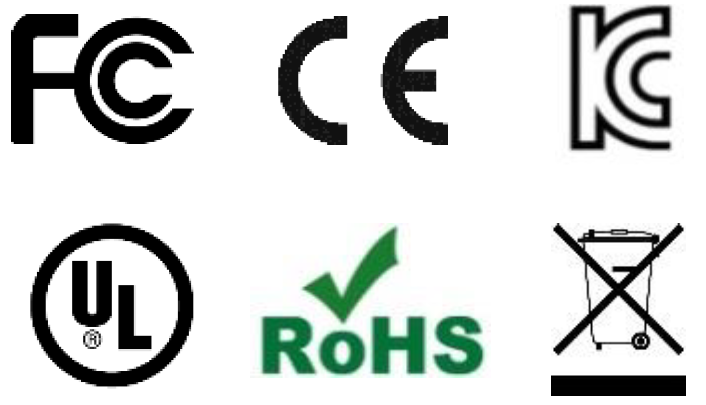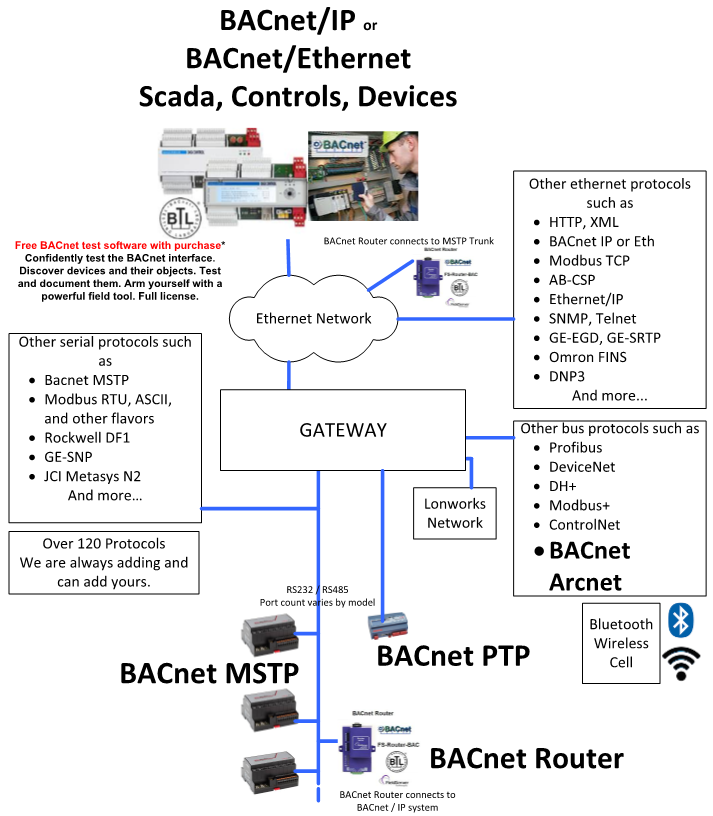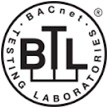BACnet IP
The BACnet/IP driver allows the FieldServer to transfer data to and from devices over Ethernet using BACnet/IP protocol. The FieldServer can emulate either a Server or Client.
All information in a BACnet system is represented in terms of objects. The Object_Identifier is a 32-bit code that identifies the type of Object (also identified by the Object_Type Property) and its "Instance" number, which together uniquely identify the Object within its BACnet device. Theoretically, a BACnet device could have over four million Objects of a particular type. The Object_Name is a text string, which has a unique capability.
BACnet devices may broadcast queries for devices that contain Objects with a specific Object_Name. This can greatly simplify project setup.
Every BACnet device must have a Device Object, which provides details about the device and its functionalities to other networked devices. Before engaging in control communications, a BACnet device must acquire pertinent information from the Device Object of the target device. Unlike other Objects, the Instance number of the Device Object must be unique across the entire BACnet internetwork, serving as the device's distinct identifier. This uniqueness facilitates easy identification of the BACnet device during installation and operation.
Standard object types are used to hold real time data and other information. Each Object Type is referenced by a number, for example 0 represents an Analog Input. See Appendix D.1 for abbreviation list.
Each Object consists of a number of prescribed properties, the main property being the Present_Value. Objects are monitored and controlled through their properties.
Quickserver Gateway (Serial-Ethernet)
The QuickServer is a high performance, fully configurable, cost effective Building and Industrial Automation gateway for integrators to easily interface devices to networks in commercial buildings and industrial plants.
System integrators world-wide have benefitted from the value of the powerful line of interoperability gateways offered by FieldServer. Now, QuickServer adds to that value by running the same robust FieldServer protocol conversion software on a highly cost effective platform backed by the experience, engineering expertise and proven technical support that integrators have come to expect from FieldServer.
QuickServer (Serial-Ethernet) is available in two series:
The QuickServer FS-QS-2X10 series is available at four different point capacities. Each QuickServer is preloaded with two drivers (serial and/or Ethernet) from a customer’s choice of 140 different drivers, E.G. Modbus, BACnet, SNMP, EtherNet/IP and many more.
The FS-QS-2010 with 2 RS485 and 1 ethernet port can support up to 250 points. The FS-QS-2210 can support up to 500 points. The FS-QS-2310 can support up to 3,000 points. The FS-QS-2410 can support up to 5,000 points.
Equivalently the FS-QS-2020 with 1 RS485, 1 RS232 and 1 ethernet port can support up to 250 points. The FS-QS-2220 can support up to 500 points. The FS-QS-2320 can support up to 3,000 points. The FS-QS-2420 can support up to 5,000 points.
Every QuickServer includes browser-based tools to make it easy to set-up QuickServer and perform diagnostics including determination of status, network settings, node information, map descriptors and more. The USB flash drive also includes the Discovery utility to determine what FieldServers are on a network.
BTL Mark is registered to the MSA BACnet Driver for MSA QuickServer line of products
Dual Ethernet Port Quickserver Gateway (Serial-Ethernet)
The Dual port QuickServer takes the QuickServers to the next level with Security and Power. With two Ethernet ports, the Dual port QuickServer allows data to move seamlessly across disparate subnets, using a dedicated port for Cloud connectivity. This port isolation allows for enhanced LAN security from the BMS/WAN/Cloud. An embedded OpenVPN Server enables secure remote access to Ethernet devices in the field.
The QuickServer FS-QS-3X10-F series is available at four different point capacities. Each QuickServer is preloaded with 140 different drivers, such as Modbus, BACnet, SNMP, EtherNet/IP and many more. See page 3 for the complete list. The FS-QS-3010-F can support up to 250 points. The FS-QS-3110-F can support up to 500 points. The FS-QS-3210-F can support up to 1,000 points. The FS-QS-3310-F can support up to 3,000 points. The FS-QS-3410-F can support up to 5,000 points. The FS-QS-3510-Fire can support up to 10,000 points.
Carrier DataLink
The Carrier DataLink Serial Driver allows variables to be read and written in system elements connected to a Carrier Comfort Network communication bus. Up to 15 system elements may be connected to a DataLink Device. Display, Occupancy, Set Point Tables and Carrier Comfort Network (CCN) variables may be read or written.
The DataLink devices provide a gateway to CCN devices. This driver polls the DataLink device which in turn reads/ writes data to the CCN devices. Carrier limits the number of CCN devices that can polled from a DataLink Device and also limits the data that can be transferred between some CCN devices and the DataLink device. For information on these limitations please consult the Carrier Corporation.
The driver is an active client driver. This means that it initiates read/write polls with the DataLink device which is expected to provide responses. Server functionality is provided by the driver too. The driver is configured to allow data tables to be read from the CCN devices via the DataLink device. As the tables typically contain more than one data element, the retrieved data is stored in a number of consecutive FieldServer data array locations in the FieldServer.
The driver can provide descriptions for each of the table values retrieved.
The driver can be configured to read a specific variable from a CNN device and store its value using optional scaling in a configurable location in a FieldServer data array.
The driver can be configured to write a value (using optional scaling) from a FieldServer data array to a specific variable in a CNN device, provided that the variable allows its value to be written.
The driver has no advanced knowledge of the CCN devices and their data tables. Therefore it cannot validate table names or variables names specified in the configuration file. In addition, this means that the driver handles each table in a generic way, without regard for the particular variables that constitute the tables.
Specifications
FS-QS-3XX0, FS-QS-2XX0
Environment
- Operating Temperature: -20 to 70°C (-4 to 158°F)
- Relative Humidity: 10-95% RH non-condensing
Power Requirements
- Input: 24VAC 0.125A, 9-30VDC 0.25A @12 VDC
- Max Power: 3W
Physical Dimensions
- Dimensions (WxDxH): 4 x 1.1 x 2.7 in (10.16 x 2.8 x 6.8cm)
- Weight: 0.4 lbs (0.2 Kg)
Other
Web configuration
On-board diagnostics
DIN rail mount included
Communication
FS-QS-3XX0
- Baud: 9600, 19200, 38400, 57600, 76800, 115000
- Serial (Galvanic Isolation): 1 x RS-485/RS-232 & 1 x RS-485
- Ethernet: 2 x 10/100BaseT, MDIX, DHCP for Dual, 1 x for Single
Approvals
- CE and FCC Class B & C Part 15
- BTL Marked
- UL 60950-1 and CAN/CSA C22 2
- IC Canada & KC Certification
- RoHS3 and WEEE complaint

Manuals
Datasheets
Case Studies
Resources
Learning about BACnet? Want to update your BACnet knowledge? This is a free EBook that will guide you through basic and advanced BACnet topics.






